Canada (PART 2)
STURGEON OF THE FRASER RIVER
Words & Images by Grant Dixon
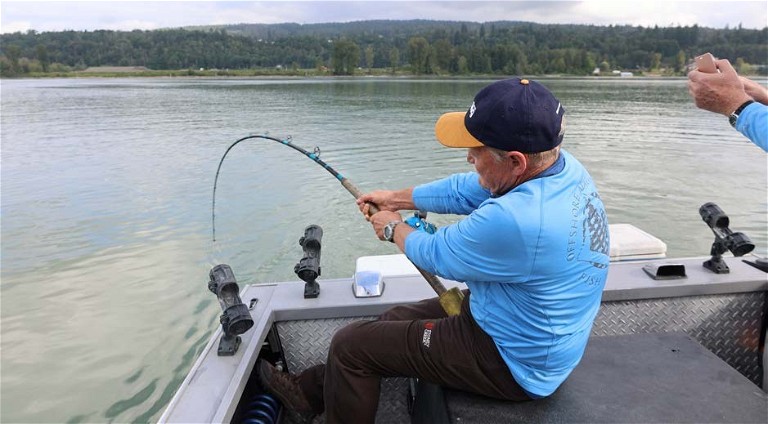
Paul locked and loaded on a tough fish.
When I first looked into the option of targeting the sturgeon of Vancouver’s Fraser River, I was not sure what to expect.
I had heard the stories shared by other Kiwi anglers who had tangled with them and had been intrigued by former colleague Jason Harman’s feature on his sturgeon encounters, published in NZ Fishing News a couple of years back.
It was with some trepidation myself and traveling companions Paul Davies and Mike Wilson stepped aboard our fishing platform – a 22ft Allumaweld alloy jetboat powered by a 5.7-litre 350 V8 Hamilton jet unit – skippered by Pat Bogdam. Would my creaking joints hold up to going toe to toe with such an adversary was just one of the concerns, or would I whimp out or end up broken?
Our guide showed us pictures of an estimated 700lb (314kg) fish caught in 2021, the biggest to ever be landed on rod and reel. It had a fork length of 11’5” (3.52m) and a pectoral girth of 55” (1.44m). Despite being estimated at over 100 years old, the fish had never been tagged, suggesting it hadn’t been caught before. Sturgeon are a catch-and-release species and are covered with strict angling rules.
What I discovered on signing up and encountering this intriguing species for the first time was an animal that could pull string like a rampant kingfish, jump like a billfish, and doggedly fight like a hāpuku in shallow water.
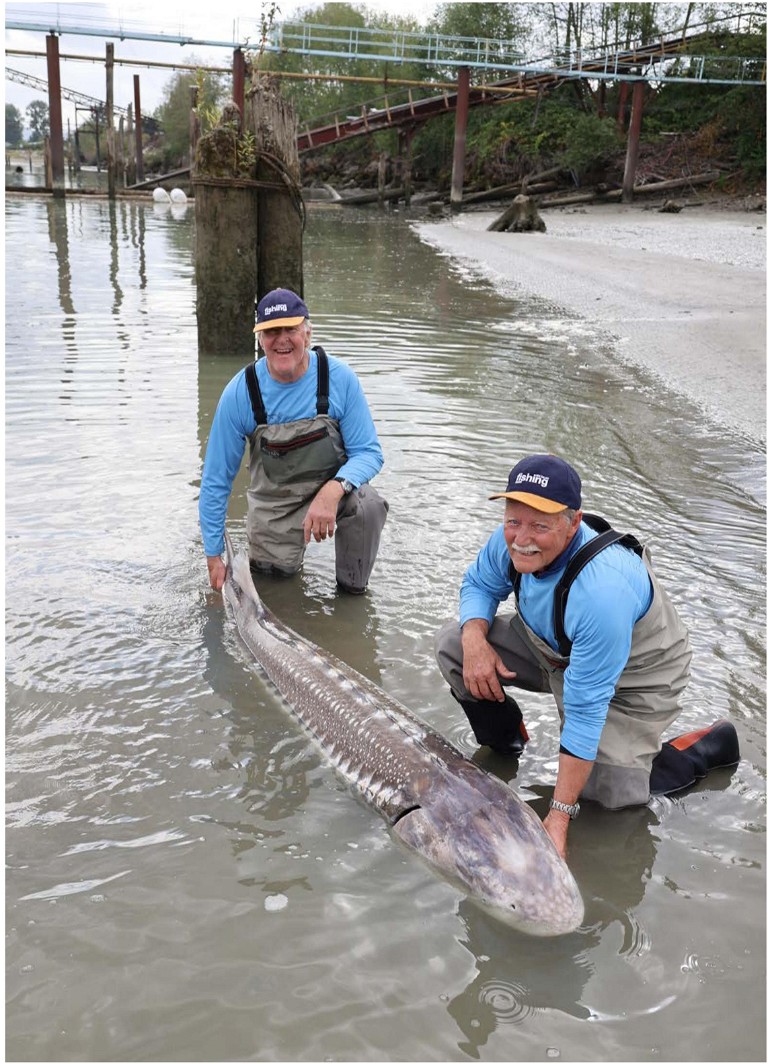
Mike Baker (left) and Paul Davies check out the first of four ‘eight footers’ landed over the three days of targeting sturgeon on the Fraser River.
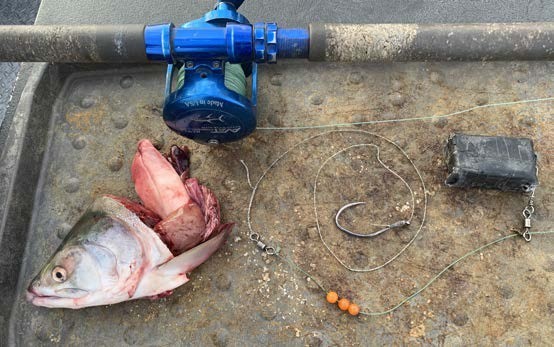
1) The basic sturgeon rig.

2) Our guide’s special ‘never fail’ sturgeon bait – salmon eggs!
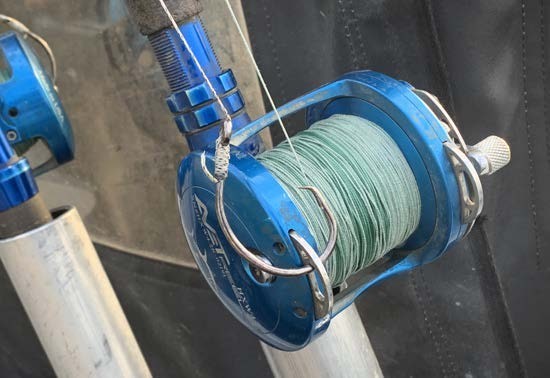
3) The substantial drag capacity of the 4/0 Evet reels was needed to bring the sturgeon under control.
Sturgeon DNA can be traced back 25 million years, and fishing for them was part two of an eightday Offshore Adventures sojourn organised by Tony Orton and Bea Bagnall. Part one, documented in last month’s issue, covered our very successful halibut, salmon, and rockfish angling efforts out of Tofino, Vancouver Island.
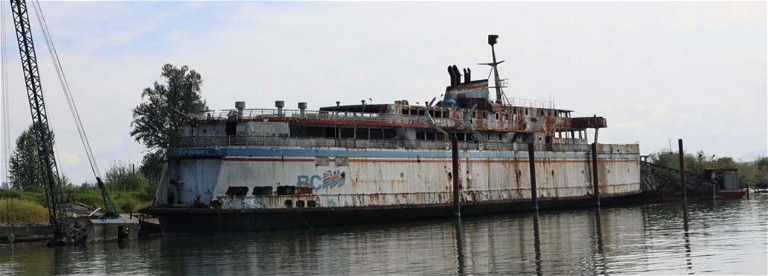
4) This old ferry was used for the filming of X-Files.
We were fortunate to land nine over our three days, four of which were over the 8’ (2.46m) and included one where the tape stopped just short of 9’ (2.77m). Unfortunately, I didn’t get to fully test the aging bod from go to whoa on one of the bigger fish, but I assisted Mike in the final stages of one of his battles.
In this instance, the angler had the fish well under control and at the back of the boat. In order to get a good image, the fish is pulled into the shallow water. This sounds simple, but in many places the banks are lined with log rafts, making finding a clear area for the photo shoot challenging at times.

The banks of the Fraser River, lined with salmon anglers and their RV home away from homes.
We worked a rotation taking strike about, and, unfortunately, the fishing gods were not smiling on me. I did get to catch several sturgeon, but none were in the 8’ plus ‘trophy’ bracket. Next time! The style of fishing was far from subtle – it was stand-anddeliver stuff. It had elements of gamefishing to it with the runs and the jumps, at other times it was down-and-dirty snapper tactics with massive head shakes, and I was reminded of a session or two of landing 40kg ‘puka in less than 100 metres of water – something akin to being attached to a runaway train.
“ STURGEON DNA CAN BE TRACED BACK 25 MILLION YEARS... ”
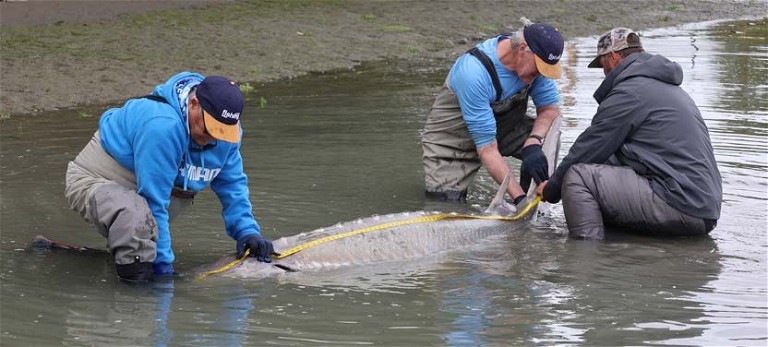
5) Detailed records are kept of all fish caught and released.
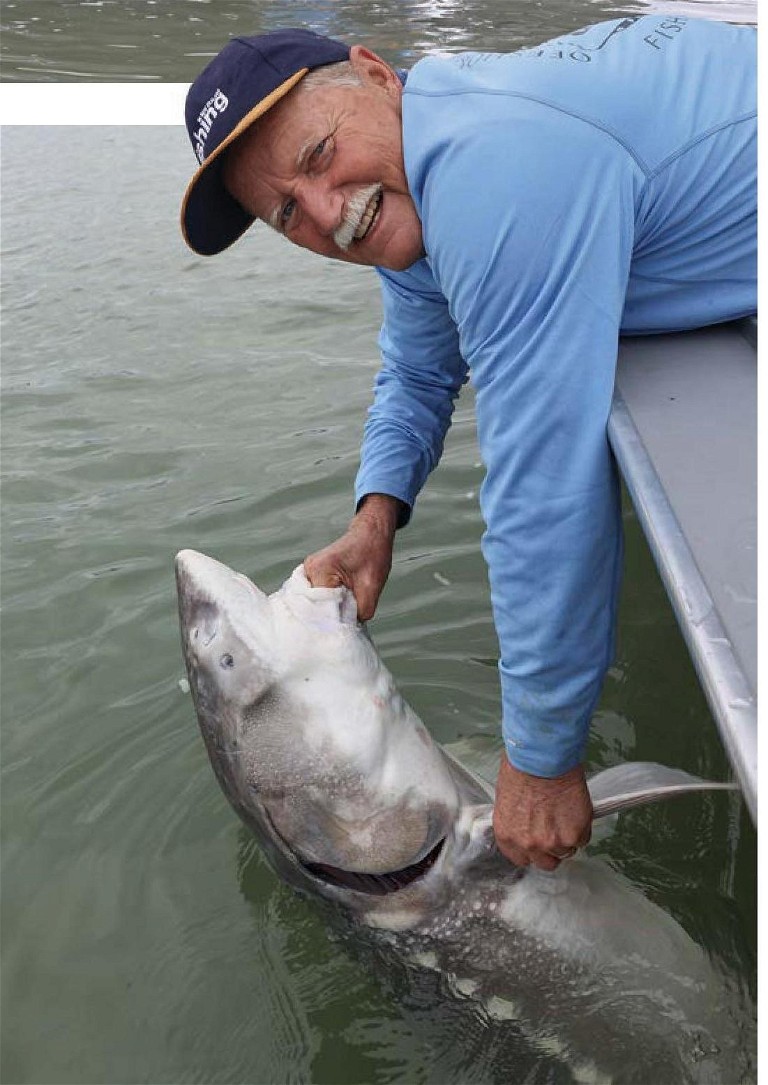
6) All fish were released.
It came as no surprise that guide Pat’s favourite bait was salmon, the stinkier the better. He mentioned one bait preparation included putting pink salmon in a bucket which would be taped up to keep the lid on the fermenting contents. The bucket would be left in the sun for a week and when it came time to deploy the bait, you needed a strong stomach and to handle the concoction with a decent pair of gloves. Fortunately, our baits included fresher salmon and Pat’s go-to, never-fail bait of fresh salmon roe bundled up in a stocking material.
Using the sidescan facility on the Humminbird sounder to cover 130 feet in either direction, Pat looked for channels and holes in the bottom where he pinged fish. On sighting them we would pull ahead, anchor up and fish back to them – something akin to how we would strayline for snapper. Sturgeon have poor eyesight compensated with a great sense of smell, hence the more pungent or oily the bait the better.
The tackle consisted of Evet HXW 4.2 Lever Drag reels spooled with 200kg braid, mounted on custom-built 2.4m long Rainshadow blank rods. The business end consisted of a 22-26oz sinker (the regulations allow up to 36oz max) with Gamakatsu or Mustad 8/0 to 16/0 circle hooks snooded to a metrelong 160lb braid trace.
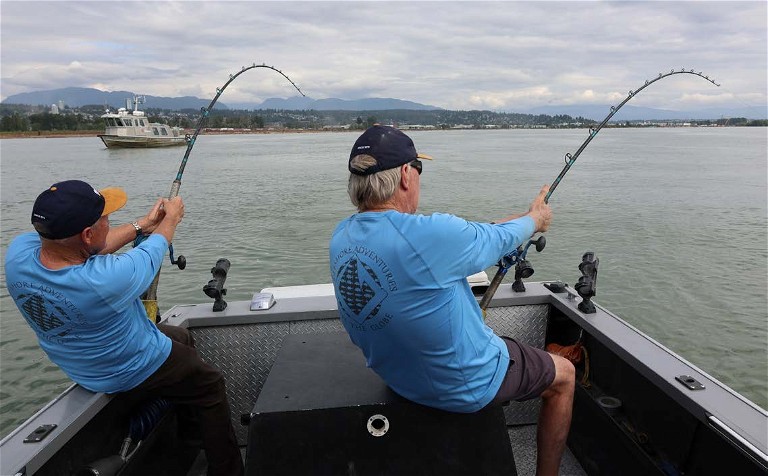
Paul and Mike go toe-to-toe with two tearaways. Both fish were over eight foot.
The hook set was just the same as for snapper fishing – take up the slack slowly to roll the hook into the corner of the fish’s mouth and once this comes up tight, drive the hook point home with two hearty double pumps of the rod. Sturgeon have bony mouths and are used to being pricked by salmon spines and bones, so if you miss the hook-up, it is not uncommon for the fish to return for a second go. Having been around for 25 million years has not taught them everything about survival!
The bite was often very soft and barely detectable. Quite often the fish would roll on the bait, ‘protecting it’ from other fish. The bigger the sturgeon, often the less obvious the bite. Smaller fish were the most aggressive ones.
These guys can pull string and the first time we hooked up, almost immediately the fish took to the air, catching me by surprise. Over the three days, despite being well aware of their aerial antics, I never got a good jump shot. Quite often the acrobatics would be at the end of the first run and by then the fish was some distance from the boat. For the bigger fish, Pat would up anchor and the chase would be on. Over the three days, we saw several ‘free jumpers’. Pat explained sturgeon were also air breathers and often came to the surface to top up their oxygen levels.

Grant hooked up on a small fish.
Of the 11 hookups, there were just a couple that did not stick, the hook pulling early on in the scrap. Once the barb was set properly, it was just a matter of holding on and making line when you could. Sturgeon are big, long, and broad fish, and once they use the current to their advantage can be difficult to shift.
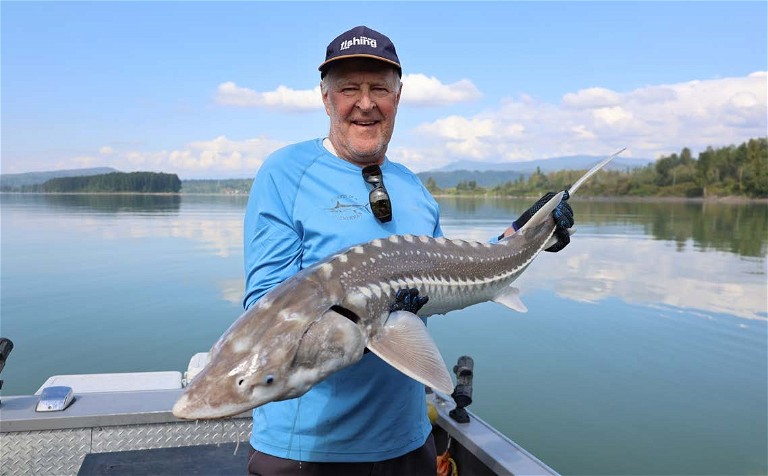
A member of the shark family, sturgeon look prehistoric which is hardly surprising as their lineage can be followed back 25 million years!
Fight times on the bigger fish were up to 30 minutes plus, longer if we needed to wrangle them ashore for photography purposes. Pat says the big capture mentioned earlier took a team of anglers around an hour to subdue.
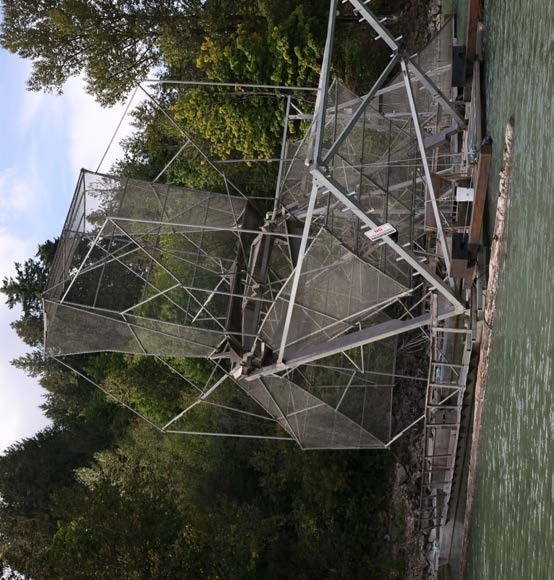
A commercial salmon trap.
I was surprised at just how docile the fish were when we had them in the shallows. They made great subjects as they allowed us in the main to set them up for the happy angler poses! You needed to be careful and use gloves when handling them as they had some particularly sharp bits!
The Fraser River is some 1,600 miles long and we fished only a short section of it. Activity on the riverbanks made for a great backdrop. We passed an old ferry used to film an X-Files television series and a vessel that had been converted into a McDonald’s floating restaurant, known as the ‘McBarge’. It was created for the 1986 World Expo but its popularity was short-lived and it now lies abandoned upriver from Vancouver city.
Fishing in the middle of a city was another interesting aspect of the sturgeon experience. It seemed quite incongruous – us enjoying some peace on the water while the city bustled on around us.
Timber is a huge part of the Canadian economy, and alongside and on the Fraser River is plenty of evidence of this. There are miles of logs rafted up alongside its bank where mills of various sizes and descriptions operate. Log tugs bustle about the place, bullying the timber rafts into submission, not unlike sheepdogs wrangling a flock into line. Huge barges carry all sorts of goods and there are signs of a commercial salmon fleet in various places, and a number of Canadians have converted old river boats into floating homes. There were plenty of people fishing for salmon off the banks with a number of anglers’ camps along the way.
Our Fraser River experience had been a unique one. Often it is the guide/skipper that makes or breaks a trip such as ours. Pat provided a very professional service. His knowledge of the river made for an interesting conversation – our apologies for the daily ‘Twenty Questions’ from three eager anglers and our thanks for willingly sharing with us. Canadians are very much like Kiwis – laid back and hospitable – and our hosts epitomised this.
These trips are often as much about the people and the environment as the fishing – Pat nailed both.